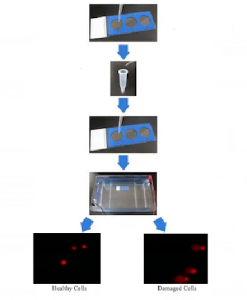Difficulties are broken one by one, and anyone who doesn't have such a good reagent kit will be heartbroken, okay?
I met a fellow student who was doing drug toxicity research,
Cell drug exposure does a lot of work upfront,
But one day
The teacher came to him and said:
You can go a little higher than normal,
Delve into organelles and genetic material levels.
The student was instantly depressed:

With limited funds at hand,
The conventional electron microscope equipment for organelle study was not available,
Genetic material has never been studied at the molecular level before,
So what?

Are there a few conventional equipment, easy to operate experimental tools can solve the urgent needs of students?
Abbkine Mitochondrial Permeability Transition Pore Assay, the opening of mitochondrial permeability transition pore is a key event that causes cell death and plays an important role in the regulation of cell survival and apoptosis!
Abbkine Comet Assay Kit (3-Well Slides), which is not only easier, time-saving and efficient, but also has bright fluorescence, and the sample is not easy to fall off, which can form stable and bright results!
Product details
| Product NO. | Product Name | Application | Size | Price ($) |
| KTA4002 | Mitochondrial Permeability Transition Pore Assay | Mitochondrial detection | 50T/100T | 159/239 |
| KTA3040 | Comet Assay Kit (3-Well Slides) | Cell DNA damage detection | 15T/75T | 249/399 |
Students who have had initial contact with these two kits may have a lot of questions. Here we will answer them one by one:
The first part is the mitochondrial Permeability Conversion hole (MPTP) test kit
Q: How does the kit measure MPTP openness?
A: Compared with the method based on mitochondrial membrane potential, this method can more directly detect the changes in the openness of mitochondrial permeability transition pore. The degree of mitochondrial MPTP opening can be determined according to the strength of Calcein green fluorescence in mitochondria. The stronger the green fluorescence, the lower the degree of openness, and the weaker the green fluorescence, the higher the degree of openness. Negative control and positive control need to be set for comparison in the experiment. Without sensitivity and detection limit data, fluorescence microscopy and flow cytometry can be detected.
Q: How to set the negative control and positive control of the kit?
A: Calcein AM staining solution was added to negative samples; Ionomycin control was added to the positive sample.
Q: Is it possible to dye the core with DAPI after dyeing the kit?
A: Abbkine's Hoechst 33342 Living cell dye (BMD0062) is recommended if nucleating. Not fixed.
Q: Can tissue or mitochondrial samples be tested?
A: Single-cell suspension of tissue can be tried. The extracted mitochondria don't fit.
Q: Which channel should the kit use for testing?
A: FITC/488 nm excitation light channel was used for detection.
Q: What are the types of samples the kit currently tests?
A: This kit detects both adherent and suspended cells, including L929 Jurkat cells.
Part 2 Comet Method DNA Damage Analysis Kit (3-well slide)
Q: What is the testing process of the kit?
A: The general steps of the kit are as follows:

Q: How do I prevent agarose gel from falling off the slide?
A: Comet slides are chemically treated with a sticky surface that absorbs agarose. The agarose fell off the slide mainly because the agarose - cell mixture was not fully covered when added to the slide hole. It is important to ensure that the agarose gel is completely covered over the hole, and it is important that the slide remains horizontal at all times.
Q: Can the Comet slide be used in batches with three holes? Can it be reused?
A: It can be used in batches, and the unused holes can be wiped dry with alcohol and continued to be used. Not reusable. The surface of Comet slides is specially treated so that once the entire slide has undergone denaturation, electrophoresis and washing, it cannot be reused.
Q: Which electrophoresis apparatus is suitable for the comet analysis kit?
A: The comet analysis kit can be used in any horizontal electrophoresis tank, not limited to any specific model, but cannot be used in vertical electrophoresis apparatus.
Q: How do I prevent agarose gel from falling off the slide?
A: Comet slides are chemically treated with a sticky surface that absorbs agarose. The agarose fell off the slide mainly because the agarose - cell mixture was not fully covered when added to the slide hole. It is important to ensure that the agarose gel is completely covered over the hole, and it is important that the slide remains horizontal at all times.
Q: Can the Comet slide be used in batches with three holes? Can it be reused?
A: It can be used in batches, and the unused holes can be wiped dry with alcohol and continued to be used. Not reusable. The surface of Comet slides is specially treated so that once the entire slide has undergone denaturation, electrophoresis and washing, it cannot be reused.
Q: Which electrophoresis apparatus is suitable for the comet analysis kit?
A: The comet analysis kit can be used in any horizontal electrophoresis tank, not limited to any specific model, but cannot be used in vertical electrophoresis apparatus.
Q: How to avoid Agarose gelation?
A: For multiple samples, the cell sample and Agarose mixture were kept at 37℃ to avoid gelation.
Q: How to avoid Agarose gelation?
A: For multiple samples, the cell sample and Agarose mixture were kept at 37℃ to avoid gelation.
These two kits have the characteristics of complete reagents, easy operation and reliable experimental results, which meet the experimental needs of scientific researchers.
In order to provide a platform for readers to learn biological knowledge, the technical experts of abbkine have made unremitting efforts to sort out a variety of high-end biological experiments. They will be published in the WeChat public account in the later period. Readers who love science are invited to continue to pay attention to the Abbkine public account.
Abbkine focuses on proteomics and cytology and is committed to the innovation and development of antibodies, proteins, analytical reagents and kits to become a key enabler of life science research and development, drug discovery and other fields. We provide you with the most popular products for the users of protein and immunology research, from the basic immunology products, such as protein extraction quantification, to internal reference labeled antibodies, primary antibodies and secondary antibodies for immunology experiments. Cell research users' favorite products, from dyes and kits for cell state detection, organelle extraction kits, cell substructure staining tracer and cell metabolism detection products, to cytokines and protein detection kits for cell culture, just to help your research career!











